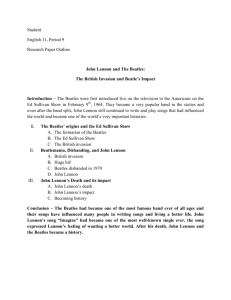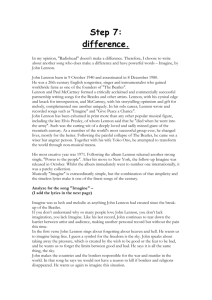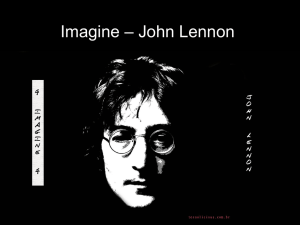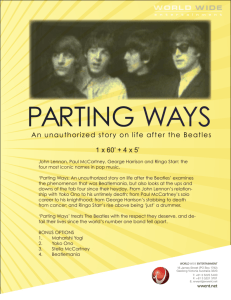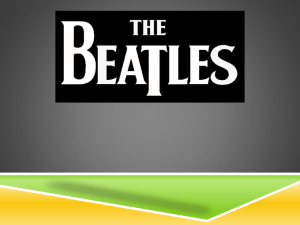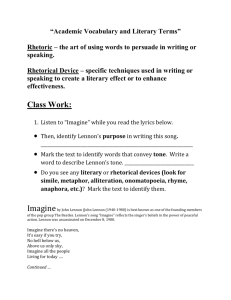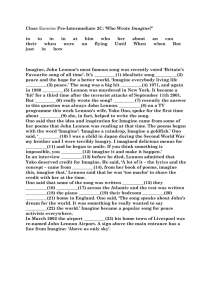John Lennon's Solo Career
advertisement
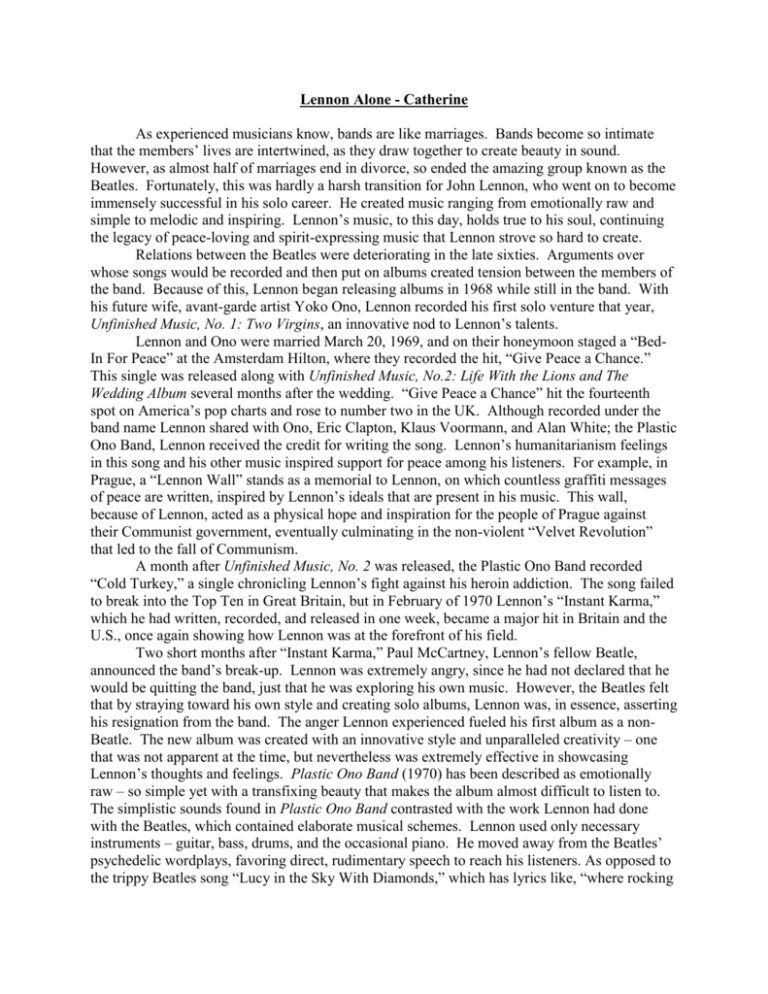
Lennon Alone - Catherine As experienced musicians know, bands are like marriages. Bands become so intimate that the members’ lives are intertwined, as they draw together to create beauty in sound. However, as almost half of marriages end in divorce, so ended the amazing group known as the Beatles. Fortunately, this was hardly a harsh transition for John Lennon, who went on to become immensely successful in his solo career. He created music ranging from emotionally raw and simple to melodic and inspiring. Lennon’s music, to this day, holds true to his soul, continuing the legacy of peace-loving and spirit-expressing music that Lennon strove so hard to create. Relations between the Beatles were deteriorating in the late sixties. Arguments over whose songs would be recorded and then put on albums created tension between the members of the band. Because of this, Lennon began releasing albums in 1968 while still in the band. With his future wife, avant-garde artist Yoko Ono, Lennon recorded his first solo venture that year, Unfinished Music, No. 1: Two Virgins, an innovative nod to Lennon’s talents. Lennon and Ono were married March 20, 1969, and on their honeymoon staged a “BedIn For Peace” at the Amsterdam Hilton, where they recorded the hit, “Give Peace a Chance.” This single was released along with Unfinished Music, No.2: Life With the Lions and The Wedding Album several months after the wedding. “Give Peace a Chance” hit the fourteenth spot on America’s pop charts and rose to number two in the UK. Although recorded under the band name Lennon shared with Ono, Eric Clapton, Klaus Voormann, and Alan White; the Plastic Ono Band, Lennon received the credit for writing the song. Lennon’s humanitarianism feelings in this song and his other music inspired support for peace among his listeners. For example, in Prague, a “Lennon Wall” stands as a memorial to Lennon, on which countless graffiti messages of peace are written, inspired by Lennon’s ideals that are present in his music. This wall, because of Lennon, acted as a physical hope and inspiration for the people of Prague against their Communist government, eventually culminating in the non-violent “Velvet Revolution” that led to the fall of Communism. A month after Unfinished Music, No. 2 was released, the Plastic Ono Band recorded “Cold Turkey,” a single chronicling Lennon’s fight against his heroin addiction. The song failed to break into the Top Ten in Great Britain, but in February of 1970 Lennon’s “Instant Karma,” which he had written, recorded, and released in one week, became a major hit in Britain and the U.S., once again showing how Lennon was at the forefront of his field. Two short months after “Instant Karma,” Paul McCartney, Lennon’s fellow Beatle, announced the band’s break-up. Lennon was extremely angry, since he had not declared that he would be quitting the band, just that he was exploring his own music. However, the Beatles felt that by straying toward his own style and creating solo albums, Lennon was, in essence, asserting his resignation from the band. The anger Lennon experienced fueled his first album as a nonBeatle. The new album was created with an innovative style and unparalleled creativity – one that was not apparent at the time, but nevertheless was extremely effective in showcasing Lennon’s thoughts and feelings. Plastic Ono Band (1970) has been described as emotionally raw – so simple yet with a transfixing beauty that makes the album almost difficult to listen to. The simplistic sounds found in Plastic Ono Band contrasted with the work Lennon had done with the Beatles, which contained elaborate musical schemes. Lennon used only necessary instruments – guitar, bass, drums, and the occasional piano. He moved away from the Beatles’ psychedelic wordplays, favoring direct, rudimentary speech to reach his listeners. As opposed to the trippy Beatles song “Lucy in the Sky With Diamonds,” which has lyrics like, “where rocking horse people eat marshmallow pies,” Lennon’s later work is creative in its simplicity. His song “Love” from Plastic Ono Band has lyrics like, “Love is real, real is love / Love is feeling, feeling love.” Simple? Definitely. Effective with that simplicity? Also a yes, since all who listen to that song know what it means. Lennon released another single in 1971 that advocated the average man taking action for peace, entitled “Power to the People.” The epitome of John Lennon’s illustrious solo music career came later that year. Imagine became a hit album, and the song itself was known as the anthem for anti-war activism throughout America, another aspect of Lennon’s humanitarianism. In this album, Lennon felt sure enough in his musical prowess to reintroduce a textured melody, sounding somewhat similar to the Beatles’ previous style, but still retaining his favored plainspokenness. “Imagine” in its time already proved great historical significance with its peace-advocating fans taking inspiration from the song, and it still lives on as the most listened to memory of John Lennon. Even in 2009, the melody of “Imagine” was played on Liverpool Cathedral’s bells during the North West’s Futuresonic festival. The reasoning behind the decision was made because, as Catherine Jones wrote in the Liverpool Daily Post, “The proposed performance will inspire thought as it yearns for peace in a broken and troubled world.” “Imagine” certainly is still influential in the world. The album Sometime in New York City in 1972 left a stain on Lennon’s gorgeous collection of music and marked the start of his fall into the “lost weekend.” The year after Sometime in New York City was released, Lennon and Ono split up, right before the release of his next album, Mind Games. Lennon’s “lost weekend” was a time of artistic drift, exploring new sides of his musical interests, and wild parties, during which he managed to produce only two albums: Walls and Bridges (1974) and Rock N Roll (1975). While trying to recover his lost voice, Lennon recorded on Walls and Bridges, “Whatever Gets You Though the Night,” a duet with Elton John that became a number one single. In 1975, Lennon and Ono ended their separation, and their son Sean was born soon after. After co-writing the hit song “Fame,” Lennon did not produce any music until 1980, when he and Ono released Double Fantasy, a work written for Sean. The couple’s plans for a full comeback were shattered when on December 8th of 1980, John Lennon, the music legend, the soulful husband and father, and the innovative humanitarian was assassinated outside of his apartment. John Lennon, in death, has lived on through his wide-ranging collection of music. From his beginning in the Beatles to his solo work, Lennon has served as a voice of change, peace, and independent thought for millions of listeners. As John Lennon sang, “Imagine all the people / Living for today.” Through the numerous styles and themes of his work, Lennon simply was trying to convey one message. Live for today. Live for love, for music, and for oneself.
